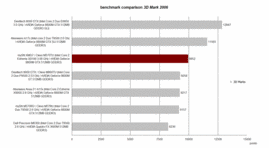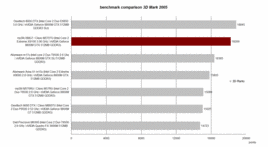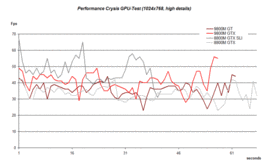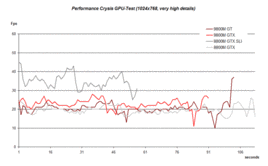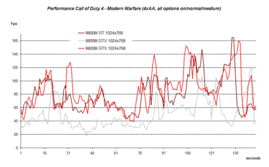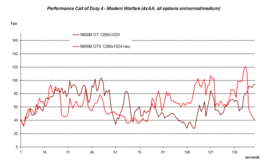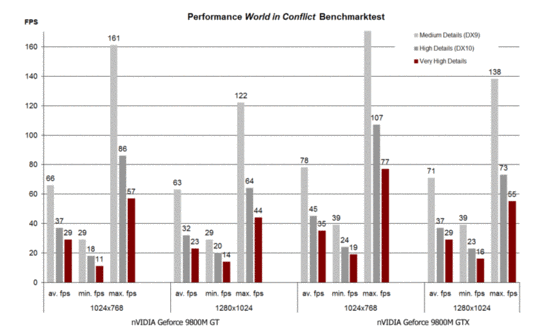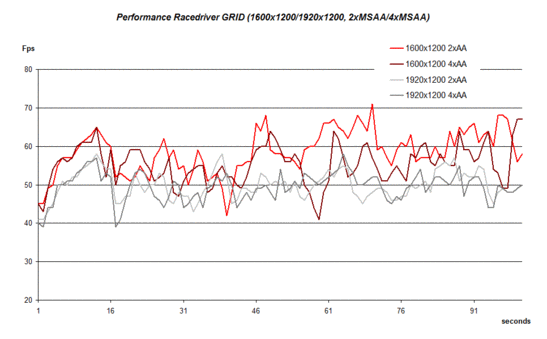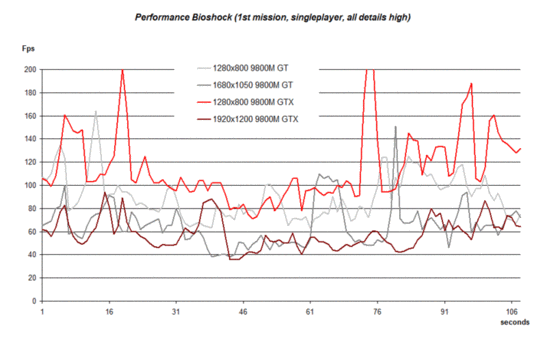Review nVidia GeForce 9800M GTX Graphics Card
Top Gaming Category
A short time ago nVIDIA launched two new graphics cards for high-end gaming. Beside the Geforce 9800M GT, which can be used in compact 15 inch models, it also offers the Geforce 9800M GTX. Based on the G92 architecture the 9800M GTX is also produced in 65 nanometre technology, but the number of its shaders is clearly higher than of the former top model by nVIDIA, the Geforce 8800M GTX.
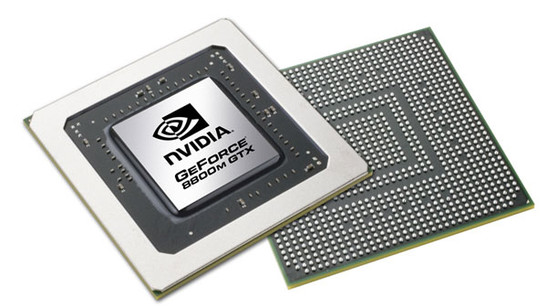
We used the mySN XMG7 gaming notebook by Schenker-Notebook for testing the brand-new 9800M GTX GPU by nVIDIA throughout this review. This is an already notebook, called M570, already often reviewed by us. This barebone by the Chinese manufacturer Clevo, is used as basis of powerful gaming notebooks by a lot of notebook suppliers. In the current version (M570TU) this notebook is already equipped with the new Intel Express PM45 chip set (Centrino 2), which allows to equip this barebone with up-to-date CPUs of the Intel Penryn line.
Schenker notebook did not hesitate and equipped the test sample with an Intel Core 2 Extreme X9100 CPU, the currently most powerful mobile processor. With a clock rate of 3.06 GHz and 6MB L2 cache this CPU clearly outperforms its Penryn competitors in a direct comparison. Further information about the performance of the Intel Core 2 Extreme X9100 CPU is available in our special article.
Performance
After we reviewed the Geforce 9800M GT graphics card, which is so to say the smaller brother of the 9800M GTX graphics chip and also based on the desktop G92 chip, but has a smaller number of shaders, it is now time to test the currently most powerful mobile graphics card by nVIDIA. The Geforce 9800M GTX graphics chip comes with 112 steam processors, which is a clear advantage compared to the 9800M GT chips, which has only 96. A further important difference is that it supports a bigger video memory capacity of up to 1024 GDDR3 video memory. Details about the 9800M GTX graphics card are available here.
Our test sample, an mySN XMG7 by Schenker notebook, which is based on the Clevo M570TU barebone, was also equipped with 9800M GTX with 1024MB GDDR3 video memory. The installed graphics driver was version 7.15.11.7602 (ForceWare 176.02).
In the 3D Mark 2006 benchmark the XMG7 achieved a respectable result of 9952 points, and is therewith nearly 10% better than comparable systems with 8800M GTX graphics card or the Deviltech 9000 DTX with 9800M GT graphics card.
Looking at the results in the 3D Mark 2005 benchmark the relative big performance gain of the XMG7 gets even clearer. Because the CPU has a bigger impact in this benchmark, it is second behind the Deviltech 8000 DTX with E6850 desktop CPU with 3.0 GHz here.
Gaming Performance
In order to be able to compare this graphics card to the already reviewed 9800M GT and 8800M GTX graphics card, we also ran a number of up-to-date games on the XMG7 test sample by Schenker notebook.
Crysis
As usual we first ran Crysis, which demands much of the hardware. We ran this game in a resolution of 1024x768 pixel and on detail levels high and very high.
With these setting and on high details the XMG7 with Geforce 9800M GTX graphics cards achieved frame rates between 30 and 50 fps, which is a rather respectable result. When we ran the first level of the demo version this game was very well playable.
If the detail level is very high the performance of the test sample shrank to frame rates between 20 and 30 fps. This is unfortunately already to low for a smooth run of this game.
Compared to the 8800M GTX chip (Alienware Area-51 m17x) and to the 9800M GT graphics chip in the Deviltech 9000 DTX the performance increases in both detail levels by about 10-15%. Nevertheless, the clear top solution is still the 8800M GTX SLI graphics solution.
Although the 9800M GTX does not allow a higher detail level in this game, it improves the performance and provides therewith more reserve capacity for a constant performance on high details. This can be especially advantageous later in the game, when complex reflections and graphical effects increase the demand on the graphics card.
Call of Duty 4 - Modern Warfare
We also tested the popular ego-shooter Call of Duty 4 by Activision. On a resolution of 1024x768 pixels, 4x anti-aliasing, all options, e.g., shadows, lights, etc. activated, and further options on normal or medium, we started playing the first single player mission.
In each frame rate protocol it gets obvious that the 9800M GTX is clearly better than the 8800M GTX. In total, you can also see slight advantages compared to the 9800M GT graphics card, but these are rather small.
Increasing the resolution to 1280x1024 Pixel while keeping the detail level the same, leads also to an interesting result. While slight advantages are observable for the 9800M GT graphics card in the first second, the 9800M GTX graphics card is, nevertheless, clearly better than the 9800 GT in the further course of the game. In the whole course of the game the 9800 GTX graphics solution has always a frame rate of above 40 fps and is so essentially better than the 9800M GT, with which the frame rate sometimes drops down to 30 fps.
World in Conflict
Because of its integrated benchmark test, the realtime strategy game World in Conflict can also be easily used to compare the performance of the 9800M GT and the 9800M GTX graphics card by nVIDIA. We tested on resolutions of 1024x768 and 1280x1024 and on medium, high, and very high details. Provided the graphical performance is sufficient, this game pampers you with DirectX 10 graphic effects when you choose at least high details.
In the direct comparison of the ran benchmark tests the Geforce 9800M GTX finally clearly wins on each resolution and detail level.
While the 9800M GT graphics card has an average frame rate of 37 fps on a resolution of 1024x768 pixels and high details, the 9800M GTX is with 45 fps clearly better. The difference is likewise clear if the details level is further increased to very high details. Here the 9800M GT chip allows 29 fps on a resolution of 1024x768 or 23 fps on a resolution of 1280x1024 pixels. The 9800M GTX is with 35 fps (1024x768) and 29 fps (1280x1024) as much as 20 or 26% better than the 9800M GT chip.
In practice, when we ran the game on a resolution of 1440x900 pixels and on very high details, the XMG7 still achieved a well playable performance of 27-45 fps (multi player, 3 vs. 3, map: seaside).
Unreal Tournament 3
As the performance of the 9800M GT graphics card (1680x1050, max details, 60-62 Fps) was impressing, we started to test this fast ego shooter by Epic on the highest level. And successful.
On maximum resolution of 1920x1200 Pixel and on maximum details (level 5/5) the XMG7 test sample was able to provide a frame rate constantly in between 58-62 fps. So, it is possible to play this game on maximum details with best performance.
Racedriver GRID
The 9800M GTX has absolutely no problems in the practical game play of the race simulator Racedriver GRID by Codemasters. We tested a course with the BMW team on resolutions of 1920x1200 and 1600x1200 pixels.
Looking at the recorded frame rates, it gets obvious that this system still provides a smooth frame rate of above 40 fps on maximum resolution of 1920x1200 pixels and with 4x anti-aliasing.
Bioshock
The 'Art Déco' shooter Bioshock by Take 2 Interactive was just recently added to our tests. This game sometimes demands a lot from the video solution by its impressing effects in the spooky undersea world.
Not surprisingly, the 9800 GTX graphics solution inside the XMG7 also convinces here. E.g., on a resolution of 1280x800 pixels and high details it provides an impressing performance of constantly more than 70 fps, while the performance of the 9800M GT graphics card in the Deviltech 9000 DTX ranges mostly from 60 to 120 fps.
The test sample is even able to make it on maximum resolution of 1920x1200 pixel and high details and keeps playable all the time with a frame rate permanently above 40 fps.
Verdict
Overall, the new 9800M GTX graphics card by nVIDIA is able to demonstrate its advantages in an impressing way. Depending on the area of operation or the chosen game, the advantage of the 9800M GTX compared to the 9800M GT and to the therewith comparable 8800M GTX graphics card is an performance gain of about 10 to 20 %.
Many of the tested games can be smoothly run on maximum resolution and on high detail level with frame rates of above 40 fps. Only very demanding games like Crysis are able to demonstrate the limits of the 9800M GTX.
Anyway, we are very excited about the 9800M GT SLI graphics solution, which should be able to set new standards and should be launched soon. Furthermore, the competitors by ATI, the Mobility Radeon HD3850 X2 and the HD3870 X2, which will be launched in the next months, are very interesting graphics solution too.
The current 9800M GTX is beside the 9800M GT graphics card and the comparably expensive 8800M GTX SLI graphics solution a very interesting alternative for the ambitious gamer. Unfortunately, only few notebooks, e.g., the mySN XMG7, which is based on the Clevo M570TU barebone, are so far equipped with the 9800M GTX graphics card. However, further models are to follow soon, e.g., the Qosmio X305 by Toshiba. And Alienware models are of course also likely to follow.
Further tests of the 9800M GTX are to follow within the comprehensive review of the mySN XMG7 (Clevo M570TU) notebook.
Many thanks to the company Schenker-Notebook, who kindly provided us with the test sample. Here you can configure and also buy the mySN XMG7 (M570TU).










